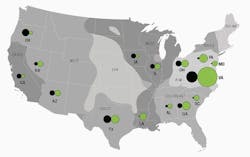The Clarion Call by Deloitte: Buffering the AI Data Center-Energy Collision
The American Society of Civil Engineers has been warning that our energy infrastructure is not up to speed and perilously in need of capital investment, and that dire alarm started sounding well before the future rush of new data centers highlighted the pressure on the power grid.
Echoing the ASCE’s longtime cry, a new report by consulting firm Deloitte is alerting energy leaders that a surge led by artificial intelligence models could overwhelm the nation’s system within a few years. Deloitte’s 2025 AI Infrastructure Survey sounds a louder warning with some hope that solutions can be streamlined and delivered in due time.
The alternative is unacceptable, industry leaders contend.
Earlier forecasts from Goldman Sachs and J.P. Morgan predicted 50 or so GWs of data center load growth due to AI and cloud-based computing by the next decade, and the Deloitte report raises that ante even higher. Power demand from AI data centers in the U.S. alone, the report reads, could grow more than 30-fold, reaching 123 GW by 2035.
This growth, all by itself, would surpass last year’s net generation capacity for all the nation’s 94 operational nuclear reactors. This blind spot in future and utility-scale power generation planning is driving many tech giants to seek future SMR and conventional nuclear deals, as well as accelerating off-grid and gas-fired power plant installation.
“The leading AI infrastructure developers that are scaling data center networks globally are known as hyperscalers,” reads the Deloitte AI Infrastructure report. “Each of the top three hyperscalers’ largest U.S. data centers currently draw less than 500 MW of power but the largest data centers they are constructing or planning to build are more than double to quadruple the capacities of completed projects. The largest of these are expected to require up to 2,000 MW—that is, 2 GW.”
The U.S. does not want to lose ground on AI to China, for obvious reasons, and the hyperscalers such as Microsoft, Google, Meta and OpenAI don’t want to lose out against each other. The competition and expansion of AI is inevitable: The rise of technology has never been thwarted, nor will it be concerning AI and cloud-based computing capacity.
There is no other choice if the U.S. is to remain the world’s technology leader.
A Deloitte analysis of data by industry firm DC Byte shows that while Virginia is still per-capita king of data center location, the 1 GW and higher hot spots are also spread out across the country, involving numerous grid interconnections.
U.S.-based power generators and data center developers agree that grid capacity and delivery is a leading challenge for data center development, the Deloitte report shows. Nearly 80% of those leaders responding to the survey say that AI will dramatically increase power demand.
All this while onshoring of manufacturing, industrial electrification and electric vehicles also will add further demand upon the grid. And there’s the interconnection queue, delaying projects by multiple years and even killing some distributed energy projects due to the slow pace of approval.
In the California Independent System Operator grid alone, close to 500 GW of carbon-free energy projects were bottled up on the interconnection queue last year. More than 200 GW of carbon-free projects were awaiting interconnection in the east coast’s PJM system, according to the Deloitte analysis of data from the Berkeley National Lab and other research reports.
“These stuck projects are key to meeting the demand of hyperscalers, which have set clean energy goals and are the leading buyers of renewable power purchase agreements,” reads the Deloitte report. “Despite these targets, load growth over the past year in the top markets for data center growth has primarily been met with increased gas generation.”
Established energy players such as Chevron certainly understand this and are ready to meet the AI growth with natural gas, as are startups such as Fermi America. Prometheus Hyperscale is partnering with independent gas producer PureWest Energy and carbon-capture firm Frontier Carbon Solutions to try and create a net-zero data center infrastructure in Wyoming, while Fidelis New Energy is developing a project incorporating gas, renewables and possibly hydrogen in West Virginia.
Workforce is another key challenge both to grid and AI buildout. Sixty-three percent of Deloitte’s respondents view labor shortages as significant impediments to infrastructure growth. Click here to see the full Deloitte AI and Energy Infrastructure Survey.
The Global Battery Storage Race is On
Read more with this free EnergyTech E-Book
About the Author
Rod Walton, EnergyTech Managing Editor
Managing Editor
For EnergyTech editorial inquiries, please contact Managing Editor Rod Walton at [email protected].
Rod Walton has spent 17 years covering the energy industry as a newspaper and trade journalist. He formerly was energy writer and business editor at the Tulsa World. Later, he spent six years covering the electricity power sector for Pennwell and Clarion Events. He joined Endeavor and EnergyTech in November 2021.
Walton earned his Bachelors degree in journalism from the University of Oklahoma. His career stops include the Moore American, Bartlesville Examiner-Enterprise, Wagoner Tribune and Tulsa World.
EnergyTech is focused on the mission critical and large-scale energy users and their sustainability and resiliency goals. These include the commercial and industrial sectors, as well as the military, universities, data centers and microgrids. The C&I sectors together account for close to 30 percent of greenhouse gas emissions in the U.S.
He was named Managing Editor for Microgrid Knowledge and EnergyTech starting July 1, 2023
Many large-scale energy users such as Fortune 500 companies, and mission-critical users such as military bases, universities, healthcare facilities, public safety and data centers, shifting their energy priorities to reach net-zero carbon goals within the coming decades. These include plans for renewable energy power purchase agreements, but also on-site resiliency projects such as microgrids, combined heat and power, rooftop solar, energy storage, digitalization and building efficiency upgrades.


